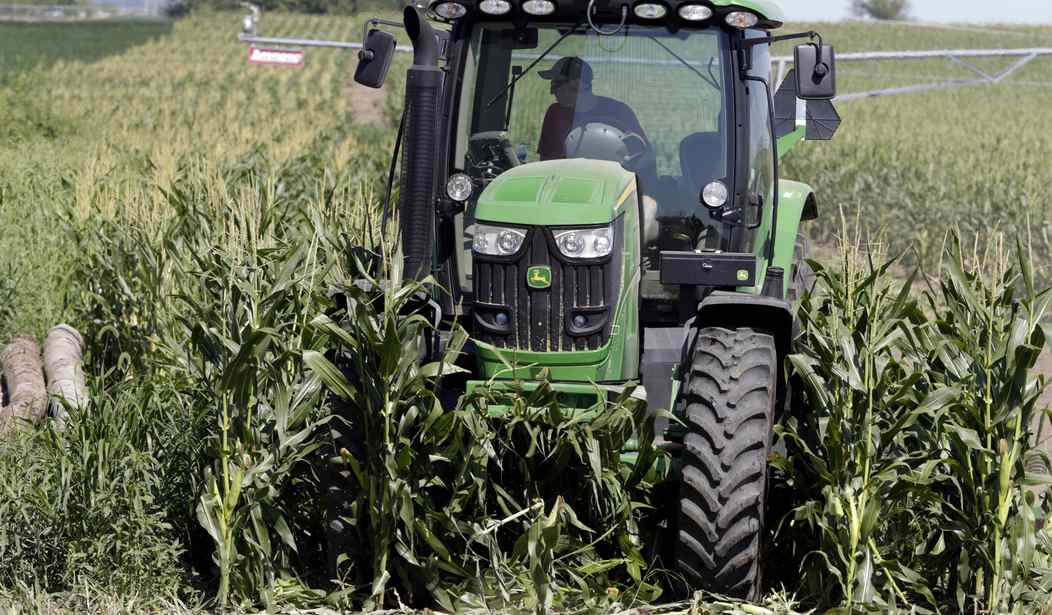Photosynthesis is the process by which plants turn sunlight into food - sugars, mostly. As I was taught it as a young man taking a degree in Biology at the University of Northern Iowa in the long-ago days of the mid-'80s, it is actually a series of reactions in which plants use light, chlorophyll, and a few enzymes to convert water and carbon dioxide (CO2) into sugars and oxygen.
Sugars and the plant fibers that contain them are food for consumers. That is animals. Including us. And we breathe in oxygen, which fuels our own cellular metabolism, producing a waste product - CO2. Neat little cycle, 'eh?
Since the Neolithic Agricultural Revolution, which may have begun as long as 12,000 years ago, we humans have depended on increasing crop yields to support our population. Now, in a stunning example of belaboring the obvious, several studies have shown that increased atmospheric CO2 and the mild warming of our climate are good for crop yields:
A farmer in South Korea’s Gyeongbok Province carefully tends to his potato field, while halfway across the world the engines of a thousand cars idle on an American interstate highway. These seemingly disconnected scenes share a bond through the fertilization effect of atmospheric carbon dioxide, which has been greening the Earth for decades.
Yes, the CO2 effluent of tailpipes and industrial flues are good for plants and all of life, contrary to the alarming tales that make this invisible gas an environmental bogeyman. Increasing CO2 concentrations are literally making the world greener, and in many cases, it’s sending crop production to record levels.
A 2020 study, funded by Cooperative Research Program for Agriculture Science & Technology Development, reported that potatoes grown in an atmosphere of elevated CO2—similar to what might be expected in coming decades—didn’t just survive but thrived!
This may come as a surprise to climate scolds, but let me assure you, it's no surprise to a biologist. Increasing atmospheric CO2 increases plant growth, including agricultural yields. That's an unalloyed good, as people need to eat - and, leaving biology for economics for just a moment, increased supply makes agricultural products more affordable, which after the last four years of Bidenflation is also an unalloyed good.
Another such study showed similar results in the Midwest:
In the U.S. too, agriculture has flourished because of the additional CO2 in the atmosphere, including in the agricultural heartland of the Midwest. As the data analysis in the CO2 Coalition’s report on the Midwest shows, it is very clear that a warming climate and the atmosphere’s carbon dioxide composition are increasing crop yields in the Midwest’s corn and soybean regions.
As Americans contribute roughly 14 metric tons of carbon dioxide per person annually, those emissions are fertilizing crops across the globe.
So, we Americans, in our kindness and largesse, are fueling crop growth around the world, as well as increasing our own usual bumper crops. The increases in CO2 are having an effect in Asia and Europe, too:
The rising emissions of China and India from their increased use of fossil fuels have contributed significantly to this global greening and has benefited ambitious tree-planting programs and intensive agriculture. Certain countries in Europe have registered an increase in forest area as well. In fact, “36 countries are gaining more trees than they’re losing,” reports the World Resources Institute.
In fact, the rate of greening due to CO2 will be much higher than the rate of browning from the expansion of arid landscapes. Researchers at a Chinese university say that “by the end of this century, drylands will expand slightly by approximately 5%, while vegetation productivity will increase by about 50%.” Elevated CO2 impedes the expansion of drylands and “greatly promotes vegetation growth with increases in both leaf assimilation and canopy foliage,” they say.
This is something you'll never hear from the Doom Pixie or any of her ilk.
See Related: Doom Pixie 2.0: 17-Year-Old Surfer Girl From Brazil 'Feels' the Oceans Growing Warmer
NASA Carbon Emissions Computer Model Scare-Mongers, but Raises More Questions Than It Answers
Biology is a hard thing to ignore or deny. Like the earth's climate, biology is complex and chaotic. Even the concept of "species" is a little on the fuzzy side; such things as cross-fertile hybrids (like polar and grizzly bear hybrids) and ring species complicate that definition quite a bit. A major problem in the use of computer modeling in biomedical research is that the best computer models humans can devise are laughably crude when compared to biological systems.
But some things in biology are well understood. The Krebs Cycle is one. Photosynthesis is another. We understand that some increase in CO2 levels is good for plants, and can increase crop yields. We understand that too little CO2 can result in a catastrophic collapse of the food web. And we do not understand the global climate well enough to interfere with it, as the results could be bad - very bad indeed.
Yes, a slight increase in CO2 can have some warming effects. So can the sun, so can volcanoes, and so can many other factors. But everything comes with tradeoffs, and if you ask people around the world who depend on plant crops for survival if they would prefer a couple of degrees cooler summers or having plenty to eat, I'm pretty sure I know which option they will choose.'
Thanksgiving is coming soon. When you dig into your creamed corn, mashed potatoes, or steamed carrots, take a moment and thank the well-understood cycles of photosynthesis - and ample atmospheric CO2.














